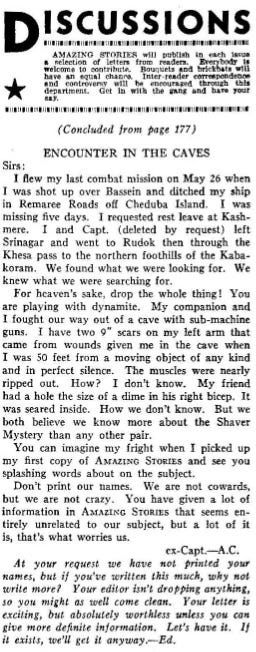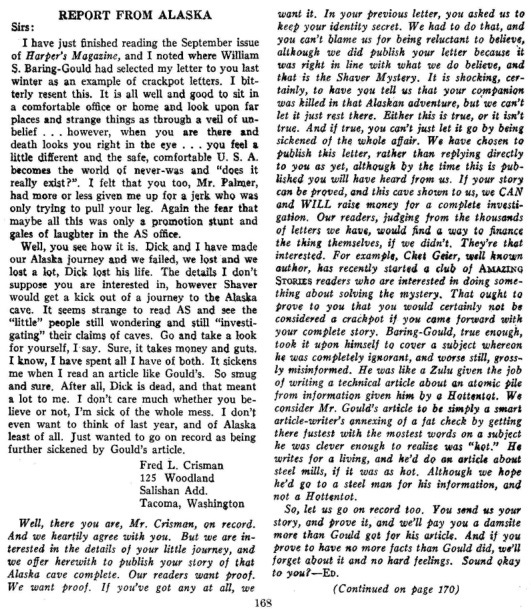Throughout the 1940s, the pulp science fiction magazine Amazing Stories published the frightening tales of Richard Sharpe Shaver, a former mental patient who began to hear voices while using a welding gun. These voices clued him in to the existence of a vast underground civilization made up of Deros (detrimental robots) and Teros, two separate offshoots of ancient advanced human societies, the former evil and the latter benevolent. Publisher Raymond A. Palmer saw the impressive appeal of Shaver’s supposedly true stories and published them regularly from 1945 until shifting to the flying saucer mystery. It is unlikely that Palmer bought the tales but found their entertainment appeal invaluable. Shaver on the other hand “believed with absolute conviction in the truthfulness of his stories.”1 When flying saucers eventually overtook the “Shaver Mystery” in popularity, Shaver’s writing influenced how the phenomenon was approached by pulp readers and editors. The two topics have retained an enduring connection to one another ever since. Michael Barkun writes that Shaver’s stories “fused with later claims about secret underground bases and tunnels”2 and I know of at least one instance where Shaver’s claims were connected to the alleged bottomless pit Mel’s Hole.3 I have written previously about Palmer letting Shaver say his piece on UFOs in a 1957 issue of Amazing Stories—unsurprisingly, according to him, they came from underground.4
Shaver historian Richard Toronto noted that Palmer and Shaver’s publication of tales from the underground “tapped into a vast, marginalized group of citizens that did in fact hear voices.”5 The magazine received a barrage of letters vouching for Shaver’s stories and seemingly confirming their reality. A couple of these letters came from a notorious figure in both the paranormal and the parapolitical: Fred Lee Crisman. While he pops up throughout the history of fringe events, Crisman was perhaps most well-known for the attention Jim Garrison directed his way during his storied investigation into the JFK assassination. One of Garrison’s press releases stated that Crisman was “engaged in undercover activity for a part of the industrial warfare complex for years.”6 Rumors further circulated that Crisman was one of the “three tramps” spotted at Dealey Plaza and suspected in connection to the assassination. Outside the realm of JFK, Crisman played a major role in the Maury Island incident, one of the first UFO cases to receive national attention beyond Kenneth Arnold’s 1947 sighting. Arnold himself was sent by Raymond Palmer (peddler of the Shaver Mystery) to investigate happenings at Maury Island. From Pilkington’s Mirage Men:
Fred Crisman showed up (…), striking Arnold as an impressive, confident character, in contrast to Dahl (the other witness), who was rather timid and slow-witted, tending to retreat from conversation when Crisman was around. (…) Crisman explained that the doughnut-shaped craft seen by Dahl were very different to the Mount Rainier objects described by Arnold. He also insisted that neither craft was anything you’d expect the American military to own, mentioning rumours that the Nazis built flying discs at the end of the war.7
Crisman was purportedly a Boeing employee at the time and man-of-a-thousand-conspiracies Michael Riconoscuito claimed that the incident was a test the aircraft company was conducting that went wrong. Crisman was sent to clean up the mess.8 To complete the chain of strange connections, Guy Bannister—who shared a suspicious office with Lee Harvey Oswald’s Fair Play for Cuba Committee location—was the FBI Special Agent in Charge at the Maury Island affair.9
Before Maury Island and before JFK, Crisman was writing in to Raymond Palmer at Amazing Stories with letters that confirmed the existence of an underground civilization of malevolent entities. After being downed during a combat mission in WWII, Crisman and his partner took leave in Burma where they purportedly encountered Shaver’s Deros in the local caves. He wrote:
My companion and I fought our way out of a cave with sub-machine guns. I have two 9” scars on my left arm that came from wounds given me (sic) in the cave when I was 50 feet from a moving object of any kind and in perfect silence. The muscles were nearly ripped out. How? I don’t know. My friend had a hole the size of a dime in his right bicep. It was seared inside. How we don’t know. But we both believe we know more about the Shaver Mystery than any other pair.10
In this initial letter, Crisman requested that his name not be printed and implored Palmer to drop the subject from the magazine. “You are playing with dynamite,” he explained. Crisman would return almost a year later, writing another letter under his real name. He complained about his previous letter being reprinted as a “crackpot letter” in an issue of Harper’s Weekly and reiterated his belief in Shaver’s caves. He reported traveling to Alaska with the same partner who helped him fight the under-dwellers in Burma. His companion was not as lucky in the Alaskan Deros caves, apparently dying during the adventure. He wrote in this letter:
The details I don’t suppose you are interested in, however Shaver would get a kick out of a journey to the Alaska cave. It seems strange to read AS and see the “little” people still wondering and “investigating” their claims of caves. Go and take a look for yourself, I say. (…) After all, Dick is dead, and that meant a lot to me. I don’t care much whether you believe or not, I’m sick of the whole mess.11
It seems that Crisman encountered Shaver’s Deros in whatever caves he happened upon. The question remains, was Crisman a crackpot who believed wholeheartedly in Shaver’s tales or was something stranger going on?
Keeping in mind the claims that he was actively involved in a disinformation campaign for Boeing that intentionally utilized the UFO myth and the fact that he might have been a perpetual agent for the goals of the military industrial complex, is it possible that his self-insertion into the Shaver story was something similar? The Shaver Mystery was a cultural phenomenon that filled a fringe niche that UFOs would eventually supplant in the years that followed. They were both promoted by Amazing Stories, Crisman popped up in both narratives, and further: “Government agents often stopped by the Ziff-Davis offices during the World War II and post-World War II years” and “a rumor circulating at the time suggested that pressure from the government made Ziff cancel (Palmer’s) promotion of flying saucers and the Shaver Mystery.”12 As in numerous other UFO and Men in Black Stories, the possibility exists that warnings to cease publishing stories of this nature were intentional ploys to make the perpetuate the narratives. What exactly the utility of the Shaver Mystery would be as a disinformation or counterintelligence method is not clear to me. However, I cannot help but notice that the stories surrounding the Shaver phenomenon prefigured the coming saucer mythology which played a lasting and complex role in military disinformation campaigns and propaganda. Perhaps some intelligence officer imagined the Shaver Mystery could incite the public to have a similar reaction. The caves must be explored and their inhabitants stopped! The military must take action! Or, as usual, maybe I am just being paranoid. The weirdness of Fred Crisman’s life could provoke that response in anyone.
Thank you for reading Getting Spooked. If you’ve enjoyed what you’ve read, consider upgrading to a paid subscription. Doing so will get you access to soon-to-be archived posts such as “The Bosco in Brazil” series which will begin getting archived in April. If you want to read more about the Shaver Mystery, Raymond Palmer, and the group of readers/writers who also heard voices, check out my book The Fortean Influence on Science Fiction. The 50th paid Getting Spooked subscriber will get a copy of the book sent directly to them. Feel free to reach out to me on Twitter at @TannerFBoyle1 for any questions, comments, or recommendations. Until next time, stay spooked.
Barkun, Michael. A Culture of Conspiracy: Apocalyptic Visions in Contemporary America. Berkeley: University of California Press, 2003. Page 33.
Ibid.
Tucker, Brian. “An Awfully Deep Hole.” Aspects of Mel’s Hole: Artists Respond to a Paranormal Land Event Occurring in Radiospace. Ed. Doug Harvey. Santa Ana: Grand Central Press, 2008. Page 92–93.
Shaver, Richard S. “Historical Aspect of the Saucers.” Amazing Stories. New York: Ziff-Davis, October 1957. Page 96.
Toronto, Richard. War over Lemuria: Richard Shaver, Ray Palmer and the Strangest Chapter of 1940s Science Fiction. Jefferson: McFarland, 2013. Page 6.
“PRESS RELEASE, OCTOBER 31, 1968 (FROM THE DISTRICT ATTORNEY, PARISH OF ORLEANS).” Assassination Inquiry Committee Newsletter. 15 November 1968. http://jfk.hood.edu/Collection/Weisberg%20Subject%20Index%20Files/C%20Disk/Crisman%20Fred%20Lee/Item%2001.pdf.
Pilkington, Mark. Mirage Men: A Journey in Disinformation, Paranoia and UFOs. London: Constable, 2010. Page 33-34.
Thomas, Kenn and Jim Keith. The Octopus: Secret Government and the Death of Danny Casolaro. Port Townsend: Feral House, 2004. Page 222.
Ibid., page 45.
Anonymous. “Encounter in the Caves.” Amazing Stories 20, no. 3. June 1946. Page 178. https://s3.us-west-1.wasabisys.com/luminist/SF/AS/AS_1946_06.pdf.
Crisman, Fred L. “Report from Alaska.” Amazing Stories 21, no. 5. May 1947. Page 168. https://s3.us-west-1.wasabisys.com/luminist/SF/AS/AS_1947_05.pdf.
Toronto, Richard. War over Lemuria: Richard Shaver, Ray Palmer and the Strangest Chapter of 1940s Science Fiction. Jefferson: McFarland, 2013. Page 158.







